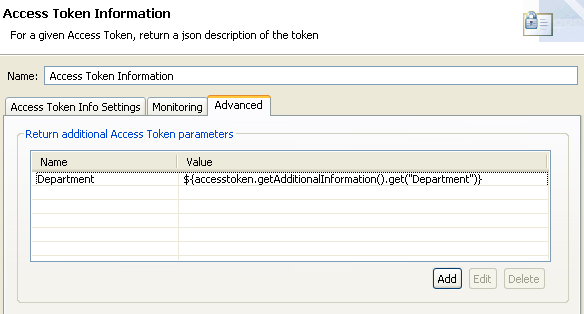Contents
Most of the OAuth 2.0 server policy filters in the API Gateway generate message attributes that can be queried further using the API Gateway selector syntax. For example, the message attributes generated by the OAuth server filters include the following:
-
accesstoken -
accesstoken.authn -
authzcode -
authentication.subject.id -
oauth.client.details -
scopeattributes
For more details on selectors, see the API Gateway User Guide.
The following methods are available to call on the accesstoken
message attribute:
${accesstoken.getValue()}
${accesstoken.getExpiration()}
${accesstoken.getExpiresIn()}
${accesstoken.isExpired()}
${accesstoken.getTokenType()}
${accesstoken.getRefreshToken()}
${accesstoken.getOAuth2RefreshToken().getValue()}
${accesstoken.getOAuth2RefreshToken().getExpiration()}
${accesstoken.getOAuth2RefreshToken().getExpiresIn()}
${accesstoken.getOAuth2RefreshToken().hasExpired()}
${accesstoken.hasRefresh()}
${accesstoken.getScope()}
${accesstoken.getAdditionalInformation()}
The following example shows output from querying each of the accesstoken
methods:
so0HlJYASrnXqn2fL2VWgiunaLfSBhWv6W7JMbmOa131HoQzZB1rNJ
Fri Oct 05 17:16:54 IST 2012
3599
false
Bearer
xif9oNHi83N4ETQLQxmSGoqfu9dKcRcFmBkxTkbc6yHDfK
xif9oNHi83N4ETQLQxmSGoqfu9dKcRcFmBkxTkbc6yHDfK
Sat Oct 06 04:16:54 IST 2012
43199
false
true
https://localhost:8090/auth/userinfo.email
{department=engineering}
The following methods are available to call on the accesstoken.authn
message attribute:
${accesstoken.authn.getUserAuthentication()}
${accesstoken.authn.getAuthorizationRequest().getScope()}
${accesstoken.authn.getAuthorizationRequest().getClientId()}
${accesstoken.authn.getAuthorizationRequest().getState()}
${accesstoken.authn.getAuthorizationRequest().getRedirectUri()}
${accesstoken.authn.getAuthorizationRequest().getParameters()}
The following example shows output from querying each of the accesstoken.authn
methods:
admin
[https://localhost:8090/auth/userinfo.email]
SampleConfidentialApp
343dqak32ksla
https://localhost/oauth_callback
{client_secret=6808d4b6-ef09-4b0d-8f28-3b05da9c48ec,
scope=https://localhost:8090/auth/userinfo.email, grant_type=authorization_code,
redirect_uri=https://localhost/oauth_callback, state=null,
code=FOT4nudbglQouujRl8oH3EOMzaOlQP, client_id=SampleConfidentialApp}
The following methods are available to call on the authzcode message
attribute:
${authzcode.getCode()}
${authzcode.getState()}
${authzcode.getApplicationName()}
${authzcode.getExpiration()}
${authzcode.getExpiresIn()}
${authzcode.getRedirectURI()}
${authzcode.getScopes()}
${authzcode.getUserIdentity()}
${authzcode.getAdditionalInformation()}
The following example shows output from querying each of the authzcode
methods:
F8aHby7zctNRknmWlp3voe61H20Md1
sds12dsd3343ddsd
SampleConfidentialApp
Fri Oct 05 15:47:39 IST 2012
599 (expiry in secs)
https://localhost/oauth_callback
[https://localhost:8090/auth/userinfo.email]
admin
{costunit=hr}
The following methods are available to call on the oauth.client.details
message attribute:
${oauth.client.details.getClientType()}
${oauth.client.details.getApplication()}
${oauth.client.details.getBase64EncodedCert()}
${oauth.client.details.getX509Cert()}
${oauth.client.details.getName()}
${oauth.client.details.getDescription()}
${oauth.client.details.getLogo()}
${oauth.client.details.getApplicationID()}
${oauth.client.details.getContactPhone()}
${oauth.client.details.getContactEmail()}
${oauth.client.details.getClientID()}
${oauth.client.details.getClientSecret()}
${oauth.client.details.getRedirectURLs()}
${oauth.client.details.getScopes()}
${oauth.client.details.getDefaultScopes()}
${oauth.client.details.isEnabled()}
The following example shows output from querying each of the oauth.client.details
methods:
confidential com.vordel.common.apiserver.model.Application@126c334d -----BEGIN CERTIFICATE-----MIICwzCCAasCBgE6HBsdpzANBg ......END CERTIFICATE CN=Change this for production Demo App Demo App Desc https://localhost:80/images/logo.png dce2efc8-e9d4-4976-8a0f-3d2a2ec3a26d 000-111-222-333 temp@axway.com d0e8952f-cefe-18e1-b2bf-8accdc456933 796501dd-7df5-4a94-a111-146c7bbab22a [https://localhost:8088/redirect] [com.vordel.common.apiserver.discovery.model.OAuthAppScope@6a25ce50] [com.vordel.common.apiserver.discovery.model.OAuthAppScope@6a25ce50, com.vordel.common.apiserver.discovery.model.OAuthAppScope@580c1ca1] true
If you add additional access token parameters to the OAuth 2.0 Access Token Info filter, you can return a lot of additional information about the token. For example:
{
"audience" : "SampleConfidentialApp",
"user_id" : "admin",
"scope" : "https://localhost:8090/auth/userinfo.email",
"expires_in" : 3567,
"Access Token Expiry Date" : "Wed Aug 15 11:19:19 IST 2012",
"Authentication parameters" : "{username=admin,
client_secret=6808d4b6-ef09-4b0d-8f28-3b05da9c48ec,
scope=https://localhost:8090/auth/userinfo.email, grant_type=password,
redirect_uri=null, state=null, client_id=SampleConfidentialApp,
password=changeme}",
"Access Token Type:" : "Bearer"
You also have the added flexibility to add extra name/value pair settings to access tokens
upon generation.The OAuth 2.0 access token generation filters provide an option to store
additional parameters for an access token. For example, if you add the name/value pair
Department/Engineering to the Client Credentials filter:

You can then update the Access Token Info filter to add a name/value pair using a selector to get the following value:
Department/${accesstoken.getAdditionalInformation().get("Department")}For example:

Then the JSON response is as follows:
{
"audience" : "SampleConfidentialApp",
"user_id" : "SampleConfidentialApp",
"scope" : "https://localhost:8090/auth/userinfo.email",
"expires_in" : 3583,
"Access Token Type:" : "Bearer",
"Authentication parameters" :
"{client_secret=6808d4b6-ef09-4b0d-8f28-3b05da9c48ec,
scope=https://localhost:8090/auth/userinfo.email, grant_type=client_credentials,
redirect_uri=null, state=null, client_id=SampleConfidentialApp}",
"Department" : "Engineering",
"Access Token Expiry Date" : "Wed Aug 15 12:10:57 IST 2012"
You can also use API Gateway selector syntax when storing additional information with the token. For more details on selectors, see the API Gateway User Guide.
In addition, the following message attributes are used by the OAuth filters to manage OAuth scopes.
The scopes are stored as a set of strings (for example, resource.READ
and resource.WRITE):
-
scopes.in.tokenStores the OAuth scopes that have been sent in to the Authorization Server when requesting the access token.
-
scopes.for.tokenStores the OAuth scopes that have been granted for the access token request.
-
scopes.requiredUsed by the Validate Access Token filter only. If there is a failure accessing an OAuth resource due to incorrect scopes in the access token, an
insufficent_scopeexception is sent back in theWWW-Authenticateheader. When Get scopes by calling a policy is set, the configured policy can set thescopes.requiredmessage attribute. This enables the OAuth Resource Server to properly interact with client applications and provide useful error response messages. For example:WWW-Authenticate Bearer realm="DefaultRealm",error="insufficient_scope", error_description="scope(s) associated with access token are not valid to access this resource", scope="Scopes must match All of these scopes: https://localhost:8090/auth/user.photos https://localhost:8090/auth/userinfo.email"
The message attribute oauth.saml.doc is set on the message whiteboard by the Get access token using SAML assertion filter.
This is a w3 dom document view of the saml bearer assertion that the API Gateway receives from an OAuth Client application.
The document in this form can be verified by other filters but in an OAuth context typically the XML Signature Verification
filter is used. See the XML Signature Verification filter in the API Gateway User Guide

